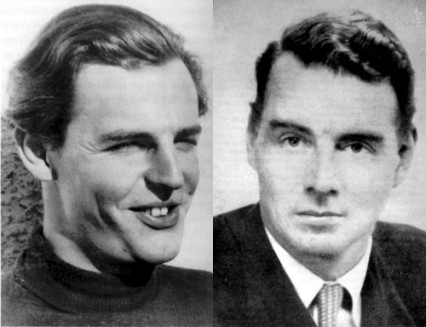
Donald Duart Maclean and Guy Francis de Moncy Burgess
Guy Burgess woke at around 9.30 on the morning of Friday, 25 May 1951 in his untidy, musty-smelling bedroom. Next to his bed was an overflowing ashtray and lying on the floor was a half-read Jane Austen novel. Since his return from Washington DC three weeks previously, where he had been second secretary at the British embassy, he had been rising relatively late.
Burgess had left in disgrace, and at the British Ambassador’s behest, after several embarrassing incidents. These included being caught speeding at 80 mph three times in just one hour, pouring a plate of prawns into his jacket pocket and leaving them there for a week and perhaps more importantly, as far as his job was concerned, he was rather too casual with important and confidential papers. This wasn’t all, while in America he had been drunk nearly continuously and he was thoroughly disliked by most of the people with whom he came in contact.
Now back in London Burgess was living in a small three-roomed flat in Mayfair situated at Clifford Chambers, 10 New Bond Street and opposite Asprey the famous jewellers. The location was (and is of course) a very salubrious part of London.
In 1951, if for some reason you had been looking for an area in the world that was visually and politically diametrically opposed to anywhere in the Soviet Union, Bond Street would have been pretty high up on your list. Burgess, the infamous Eton and Cambridge-educated Soviet spy, coped with the irony with surprising ease at least until this Friday morning when his world suddenly turned upside down.
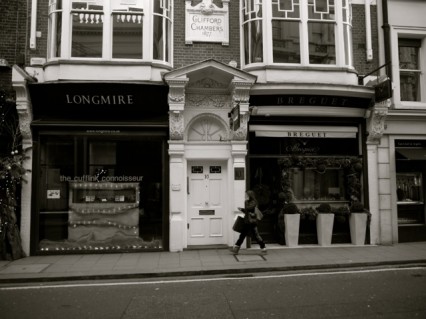
Clifford Chambers, 10 New Bond Street in Mayfair today.
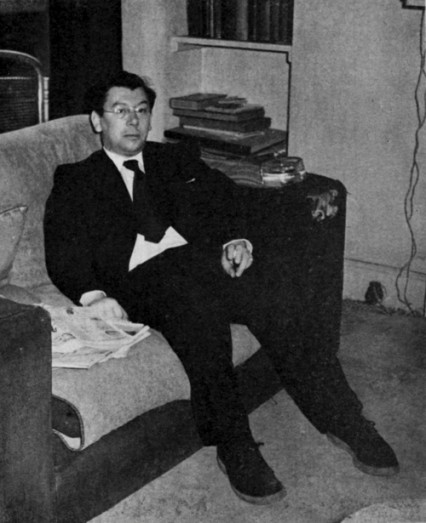
Jack ‘Jacky’ Hewit
Not long after he had woken Burgess had been brought a cup of tea by his flatmate, and erstwhile lover, Jack Hewit. Known to to his friends as ‘Jacky’, Hewit was now a slightly over-weight office clerk but had once been a ballet and chorus dancer in the West End. They were now very close friends and had been sharing various flats in and around Mayfair for fourteen years. Hewit later wrote of that morning:
Guy lay back, reading a book and smoking, and he seemed normal and unworried. When I left the flat to go to my office, Guy said ‘See you later, Mop’ – that was his pet name for me. We intended to have a drink together that evening.
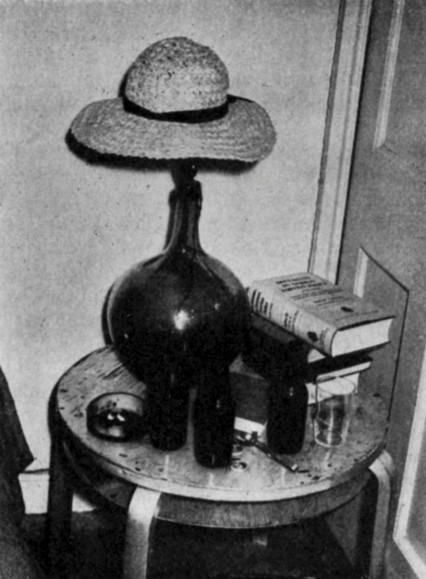
Burgess and Hewit’s flat on New Bond Street.
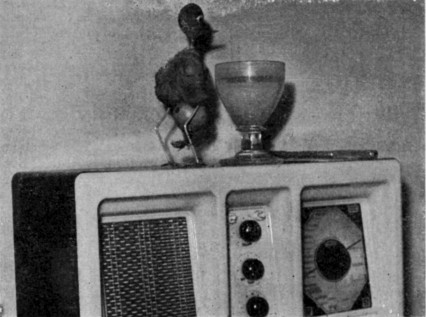
Not the most salubrious flat in Mayfair.
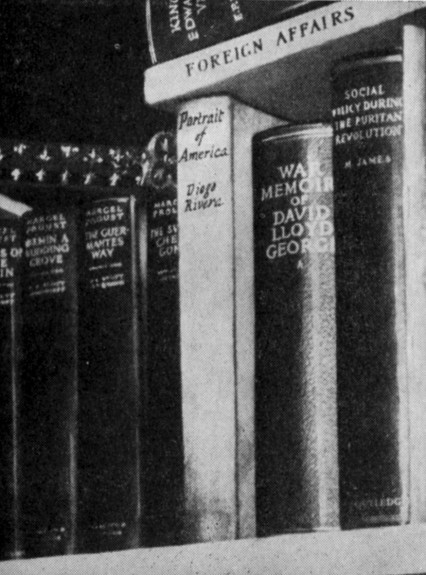
Burgess’s books he eventually left behind he took with him a volume of Jane Austen’s collected novels.
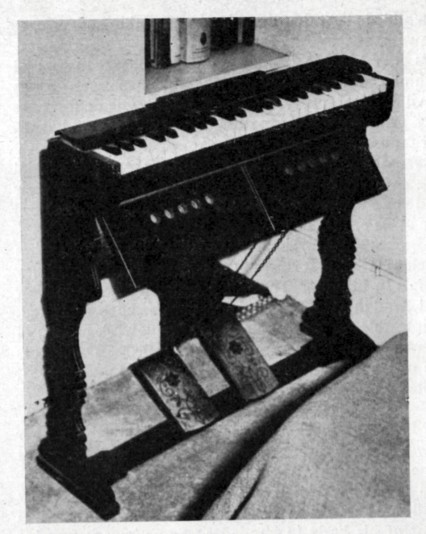
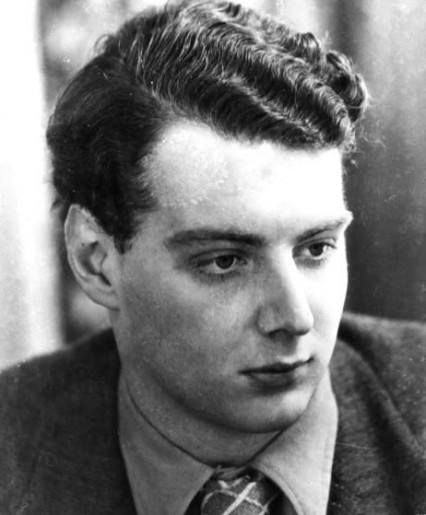
At the same time as Burgess was waking up, Donald Duart Maclean had already caught his usual train from Sevenoaks some two hours previously and was sitting at his desk in Whitehall. He was head of the American department at the Foreign Office in King Charles Street.
The job sounds important but care was already being made that it was of no operational significance. For several weeks now, along with three other suspects, Maclean had been under suspicion for leaking atomic secrets to the Soviet Union. In the last few days, however, the four had become just one.
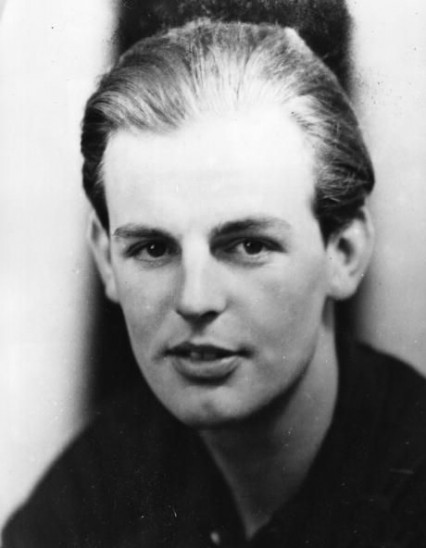
Donald Maclean in 1935 aged 22
Two years younger than Burgess, Maclean was exactly 38 years old for it was his birthday and he had asked if he could take the next morning as leave (Saturday mornings were still worked by many civil-servants in the 1950s) so he could celebrate with family friends at home in Surrey.
Maclean was the son of one of the most illustrious Liberal families in the country. His father, Sir Donald Maclean, had first entered Parliament as the Liberal member for Bath in 1906 and was President of the Board of Education in the cabinet when he died in 1932.
At around 10-10.30 that morning a senior MI5 officer and the head of Foreign Office security were received by Mr Herbert Morrison, who had recently become Foreign Secretary, in his large office in Whitehall. After reading a few papers Morrison signed one of them. This gave MI5 permission to question Donald Maclean about links with the Soviet Union.
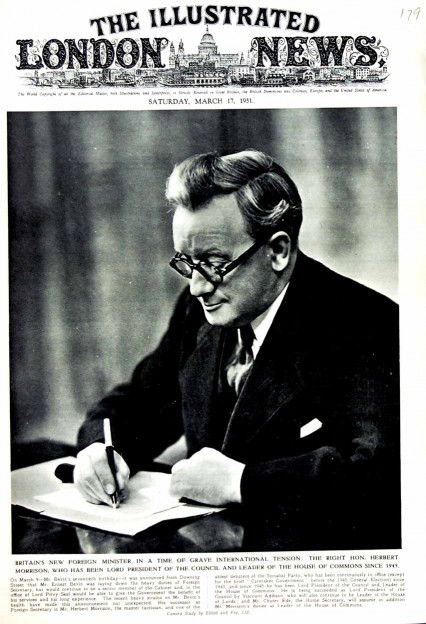
Herbert Morrison in 1951, his daughter gave birth to Peter Mandelson two years later
Both Maclean and Burgess knew something was wrong. A few days previously they had met for lunch. Originally intending to eat at the Reform club they found the dining room full and they walked to the nearby Royal Automobile Club along Pall Mall. Ostensibly they were meeting about a memorandum that Burgess had previously prepared about American policy in the Far East and the threat of McCarthyism, but on the way Maclean said:
I’m in frightful trouble. I’m being followed by the dicks.
He pointed out two men standing by the corner of the Carlton Club and said, “those are the people who are following me.” Burgess later described the two men:
There they were, jingling their coins in a policeman-like manner and looking embarrassed at having to follow a member of the upper classes.
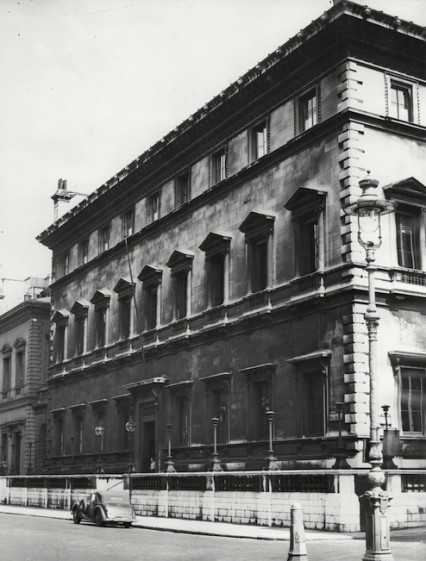
London Reform Club, 104 Pall Mall in the fifties
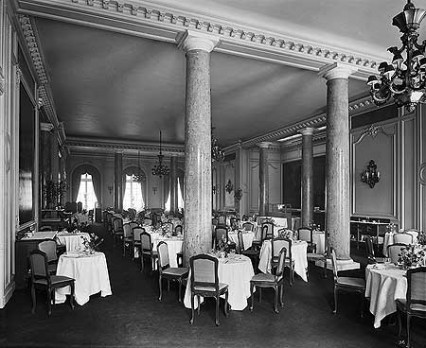
Dining room at the Royal Automobile Club
At around the same time as the Herbert Morrison meeting in Whitehall, Burgess left his flat in New Bond Street. He had just received a telephone call from Western Union relaying a telegraph from Kim Philby in Washington about a car he had left behind in Washington. In reality it was a coded message that Maclean would be interrogated after the weekend.
Burgess hurried to the Green Park Hotel on Half Moon Street (a former town house in a terrace built in 1730 – the hotel is still there and is now known as the Hilton Green Park Hotel) just off Piccadilly and about ten minutes walk from his flat. At the hotel he met a young American student called Bernard Miller whom he had befriended on his journey back from the US on the Queen Mary. Burgess later described him as - “an intelligent progressive sort of chap” .
They had a coffee in the hotel’s comfortable lounge and then went for a walk in nearby Green Park. They had previously planned a short trip to France and Burgess had already booked two tickets for a boat that sailed that night. They hadn’t been walking long before Burgess suddenly stopped, turned to his surprised American friend who had been animatedly chatting away about their trip, and said:
Sorry Bernard, I haven’t been listening, really. You see, a young friend at the Foreign Office is in serious trouble, and I have to help him out of it, somehow.
Burgess assured the shocked Miller that he would do everything he could to make their midnight channel-ferry but he couldn’t be definite until a few hours later.
By now it was just before midday and the American went back to his hotel and Burgess went to the Reform Club for a large whisky and a think about what was lying a head. After half an hour he asked the Porter to call Welbeck 3991 and ordered a hire-car for ten days.
While Burgess was slumped in a large corner armchair at his club Maclean left his office and walked up Whitehall and across Trafalgar Square to meet a couple of friends for lunch in Old Compton Street. They walked through a door which was part of a green facade with the heading ‘Oysters/WHEELER’s & Co./Merchants’ written along the top.
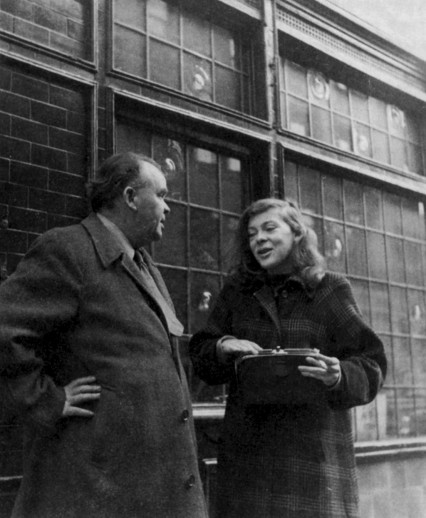
Cyril Connolly and Caroline Blackwood (soon to become Mrs Lucian Freud) outside Wheelers in 1951. Connolly, the writer and critic, was a friend of Burgess. Two days after Burgess returned to London he described Washington to Connolly: “Absolutely frightful because of Senator McCarthy. Terrible atmosphere. All these purges.”
In the early fifties Wheeler’s restaurant was a Soho institution. The owner was Bernard Walsh who started Wheeler’s in Soho in 1929 as a small retail oyster shop. Noticing how popular his oysters were in London’s top restaurants he bought a few tables and chairs and started serving them himself. By 1951, when Maclean and his friends visited for lunch, the restaurant featured a long counter on the left-hand side where a waiter or Walsh himself opened oysters at frightening speed.
There was a large menu which had thirty-two ways of serving sole and lobster but no vegetables save a few boiled potatoes. During post-war austerity when English food was at its dreariest and some of it still rationed, Wheeler’s seemed a luxury.
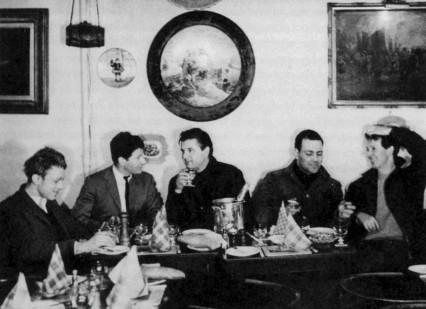
Francis Bacon with friends, including Lucian Freud and Frank Auerbach at Wheeler’s in 1951/2
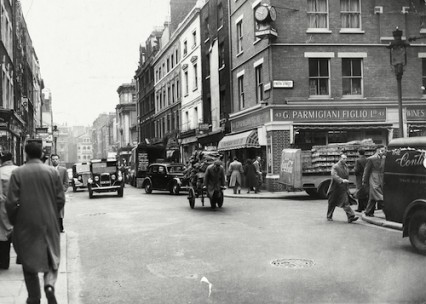
When Donald Maclean came out of Wheeler’s and turned left this would have been his view in 1951
The restaurant was very crowded on that particular Friday lunchtime and after sharing a dozen oysters and some chablis at the bar Maclean and his friends decided to eat the rest of their lunch elsewhere. Maclean seemed unconcerned and almost nonchalant as he and his friends walked up Greek Street, through Soho Square on to Charlotte Street where they had two further courses at a German restaurant called Schmidt’s situated at numbers 35-37.
This area of London was still known to most people then as North Soho. The name Fitzrovia would generally not be used for a decade or two and was named after the Fitzroy Tavern. Coincidentally ‘Fitzrovia’ was recorded in print for the first time by Tom Driberg, the independent and later Labour MP – and a close friend of Guy Burgess.
Most of the staff at Schmidt’s had been interned during the second world war which maybe explained why the waiters were infamously known as the rudest in the world. In the early 1950s the restaurant still served food using an old European restaurant custom where the waiters brought meals from the kitchen and only then sold them to the customers.
After his relatively long lunch Maclean said goodbye to his friends and gratefully accepted an offer that he could stay with them while his wife was in hospital having their baby. She was only two weeks from having their third child and he said he’d call them in the following week to arrange the details.
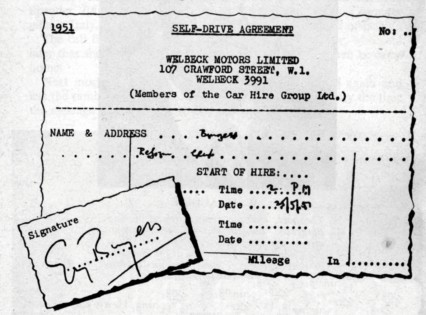
The Welbeck Motors car hire form. Burgess writes his address as ‘Reform Club’.
While Maclean was having lunch Burgess called on Welbeck Motors at 7-9 Crawford Street half a mile or so north of Marble Arch to pick up his hire-car. It was an Austin A70 and was due to be returned on June 4th, ten days later. He paid £25 cash in advance – £15 for the hire of the car and £10 deposit.
Welbeck Motors became famous throughout the country ten years later when they created the first major fleet of mini-cabs. The fleet cost £560,000 and consisted of 800 Renault Dauphine cars that were being built in Acton at the time. Michael Gotla, the man behind the skillful publicity of Welbeck Motors, argued that the 1869 Carriage Act only applied to cabs that “plied for hire” on the street. He argued that his mini-cabs, could break the former black-cab monopoly because they only responded to calls phoned to their main office the number of which was WELBECK 0561.The fares, much to the chagrin of the traditional cabbies who charged far more, were only one shilling per mile .
The Renault Dauphine had the nickname “Widow-maker” due to its very unsafe cornering but the Welbeck Motors fleet of mini-cabs a huge success particularly to people who lived outside central London. The cars were also noticeable as the first to feature third-party advertisements on their bodywork,.
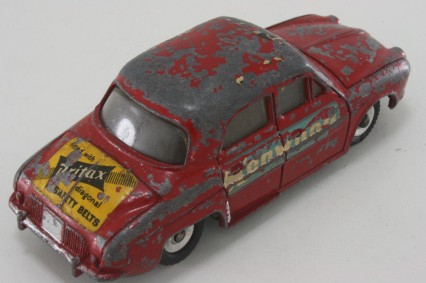
A Corgi model of a Welbeck Motors’ ‘widow-maker’ Renault complete with advertising
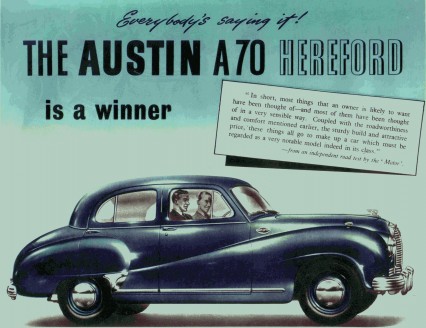
The Austin A70
Burgess drove the Austin down to Mayfair where he dropped into Gieve’s the tailors at number 27 Old Bond Street at around 3 pm. The two hundred year old company had only been at the premises for about ten years as the original flagship store a few doors down at number 21 had been destroyed by a German bomb in 1940.
Gieves and Hawkes, incidentally, now possibly the most famous bespoke tailoring name in the world, only merged in 1974 when Gieve’s Ltd bought out Hawkes enabling it to also acquire the valuable freehold of No. 1 Savile Row. The acquisition was good timing because Gieve’s flagship store in Old Bond Street was again destroyed by high-explosive not long after the merger, this time courtesy of the IRA. From 1975, number 1 Savile Row became Gieve’s and Hawkes which is where it is today.
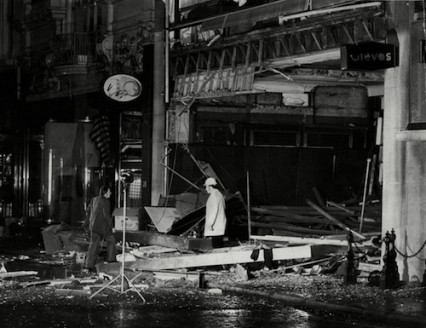
Gieve’s after the IRA bomb in 1974
At Gieve’s, Burgess bought a ‘fibre’ suitcase and a white mackintosh and then went to meet Miller again. After a couple of drinks he dropped the young American back at his hotel telling him: “I’ll call for you at half-past seven.” Burgess didn’t, and Miller never saw him again.
After his relatively long lunch Maclean took a taxi down to the Traveller’s Club – the West End club that had long been associated with the Foreign Office. He had two drinks at the bar and cashed a cheque for five pounds which he did most weekends so it wouldn’t have seemed unusual. There wasn’t anyone at the club he knew and he returned to his office just after three.
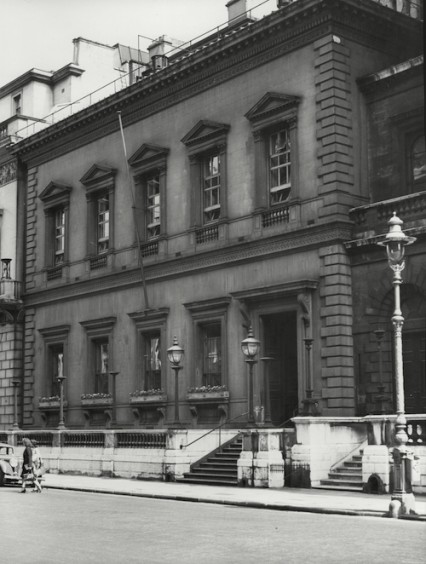
Traveller’s Club at 106 Pall Mall
Burgess drove back to the flat where he met Hewit who had by now returned from his office. While they were talking the phone rang which Burgess quickly answered and made it clear that he was talking to Maclean. Visibly upset Burgess left the flat almost immediately and he was never to see Hewit again. He had time before leaving to grab £300 in cash and some saving certificates and packed some clothes and his treasured copy of Jane Austen’s collected novels in his new suitcase. He also asked to borrow Hewit’s overcoat.
Burgess was next seen at the Reform Club in Pall Mall where he asked for a road map of the North of England presumably to lay a false trail and from there he drove to Maclean’s home at Tatsfield in Surrey.
Maclean left the Foreign Office at exactly 4.45 and walked up Whitehall to Charing Cross Station joining the hurrying commuter crowd. The two Mi5 ‘dicks’ were of course still following him but it was only as far as the station where they made sure he got on his usual 5.19 train to Sevenoaks
The two friends arrived within half an hour of each other at Maclean’s house. Burgess was introduced to Melinda, Maclean’s wife, as Mr Roger Stiles – a business colleague. They all sat down for the birthday dinner at seven for which Melinda had cooked a special ham for the occasion. After the meal Maclean put a few things into a briefcase including a silk dressing gown and casually told his wife that he and ‘Stiles’ would have to go on a business trip but would not be away for more than a day.
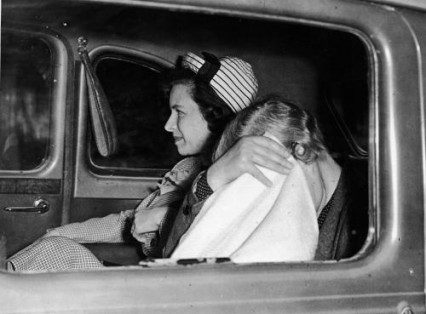
Melinda Maclean leaving hospital in June after the birth of her baby. She once wrote to her sister saying: “Donald is still pretty confused and vague about himself, and his desires, but I think when he gets settled he will find a new security and peace. I hope so…He is still going to R. (the psychiatrist), however, and is definitely better. She is still baffled about the homosexual side which comes out when he’s drunk, and I think slight hostility in general, to women.”
With Burgess at the wheel of the cream-coloured Austin A70 hire-car they set off for Southampton at around 9 pm. Their destination was Southampton 100 miles away. The cross-channel ferry ‘Falaise’, for which Burgess had his previously bought tickets, was due to leave for St Malo at midnight. They made it with just minutes to spare and after abandoning the Austin on the quayside they ran up the gangway almost as it was being raised. A dock worker called at them: “What about your car?” Burgess shouted: “I’m back on Monday.”
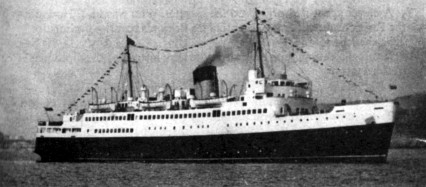
The ship that Burgess and Maclean took to St Malo
He wasn’t of course and Burgess and Maclean never set foot in Britain again. It wasn’t until five years later that Krushchev admitted that the two traitors were now living in the Soviet Union. Burgess, who perhaps unsurprisingly didn’t really enjoy the Soviet lifestyle, continued to order his suits from Savile Row. In 1963 he died of chronic liver failure due to alcoholism.
Maclean found it far easier than his spying partner to assimilate into the Soviet system and became a respected citizen. He died of a heart attack in 1983.
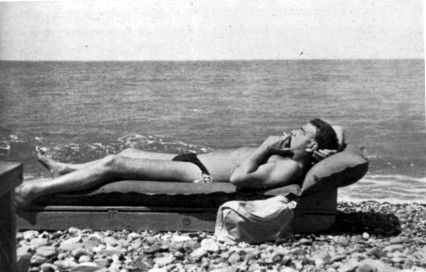
Burgess sunbathing in Russia and making the best of a place he hated.
Ian Fleming’s first James Bond novel was written in 1952, the year after Burgess and Maclean’s defection. In it, James Bond has a rare crisis of confidence:
This country-right-or-wrong business is getting a little out-of-date,” he says, “Today we are fighting Communism. Okay. If I’d been alive fifty years ago, the brand of Conservatism we have today would have been damn near called Communism and we should have been told to go and fight that. History is moving pretty quickly these days and heroes and villains keep on changing parts.
The ‘Third Man’ Kim Philby at a press conference in 1955 after he had been accused in Parliament of being an associate of Burgess and Maclean. He shows the confidence and extraordinary charm that enabled him to keep undercover for so long. He defected to Russia from Beirut in 1963 and died in 1988 of heart failure. While in the Soviet Union he had an affair with Melinda Maclean.
The ‘Fourth Man’ Anthony Blunt being interviewed by Richard Dimbleby as the Surveyor of the Queen’s Pictures. Blunt was one of the first people to search Burgess’s flat after he had absconded enabling him to remove any incriminatory material.
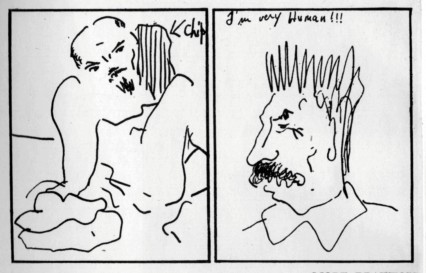
Obviously not documents considered ‘incriminatory’ by Anthony Blunt but these drawings of Lenin and Stalin by Burgess were left behind in the flat at New Bond Street after he had fled to Russia
Tags: bombs, fifties, gay, politics, scandal, sex, spying, terrorism, traitors, WW2
My grandfather introduced Burgess to Maclean at Cambridge – I’ve got a photo of them all in a march in 1936 I can send to you if you are interested.
Thanks fro very interesting blog
A strange co-incidence if you read the comments under the news article -http://www.theargus.co.uk/news/9459190.Man_killed_in_Brighton_named_as_Christopher_McLean/?ref=la
Hi Suzy, I’d be very interested in seeing the photo. Thanks. Rob
Another fascinating post. Where on earth do you manage to dig up all the source material? Top stuff.
This was fantastic, as usual. Always happy to see a new post, no matter how long the wait. Many thanks for the effort.
Fascinating! I’d seen photos of Philby but never a newsreel. Frankly, though he was a handsome man, in this film he makes some very odd facial or mouth movements—somewhere between a naughty child and a man with toothache. Today, with so much development in “face-reading” and the analysis of micro-expressions, he would probably be identified as a liar very quickly indeed.
Not even sure how I stumbled onto to your site but I’m so glad I did. I’ve just spent a couple of hours reading some great stuff. Thanks! And please keep posting!!!
Fascinating. My biography of Burgess, on which I’ve been working for many years and has the cooperation of the family, will be published shortly but love to see any photos or material people have. Andrew Lownie
I am very impressed by the deepness and accuracy of your research. Do you know something about burgess and mclean passage to st Malo and Rennes and further. I should be interested In knowing
J. Y Ruaux
Your blog presence is quite inspirational sir. Always interesting and great use of sources.
Mat
very interesting, sir Anthony Blunt had the most awful row with Burgess who accused of giving him the pox, Burgess siad take it up with Tom Driberg as he gave it to me !!
Interesting; does anyone have a photo of Schmidt’s in the 50′s? My father seems to have worked there for a time, although quite why, since he was a stamp dealer, I do not know!
I am so pleased to have been directed to your website via the Kent History Forum. First class material incredibly well researched. I am Bookmarking and returning soon!
I learn such a lot about London from this blog, many thanks. On Gieves and Hawkes website it says that the Bond St store was bombed in Jan 1975, so it could well have been the work of the IRA active service unit captured at Balcombe Street.
Really enjoying the site in general, but this article in particular. In the late ’70s we lived in Philby’s old house in Chelsea, No 18 Carlyle Square, the square directly across King’s Road from the Chelsea Antiquarius.
Why would Burgess have been in Dublin with his mother immediately before his defection? is there any record of this other than the following story?
In 1991 I was posted to Moscow as The Irish Times correspondent. Before my departure I had drinks with Lord Killanin who had been a contemporary of Burgess’s at Eton and Cambridge. He told me the following story:
Very shortly before B and McL skedaddled he (Killanin) was walking through St Stephen’s Green in Dublin where he saw Burgess, very drunk, making a nuisance of himself by accosting young men.
“My father,” Killanin told me “had given me good advice about how to deal with such a drunk and that was to ply him with so much more drink that he would be incapable of causing further trouble.”
Killanin took Burgess to the Shelbourne Hotel nearby where he was staying with his mother. They went to the bar where K soon had B in a state in which he had to be carried to his room.
Some days later K read a short paragraph in the Evening Mail that a British Diplomat had been charged with drunken driving. K investigated the matter and discovered that the British Embassy had pulled strings to have the charge dropped. According to K Burgess left immediately for London and onwards to St Malo and Moscow.
The idea that the Embassy had saved a traitor from arrest has always intrigued me. Although a diplomat Burgess would not have had immunity in Dublin as he was not accredited there.
Dear Suzy Gillett (see top comment!)
I am doing some research into the topic and would love to see that photograph and have a chat with you!
I don’t know if this message will come into your inbox, but it would be great to hear from you if you are free!
Very best
Ben
Dear Suzy, Very interesting.Only those who lived in the USSR in those days when Burgess turned up there could understand how deep and how enormous his sorrow and disappointment were.I think he kept repeating to himself the Molliere’s phrase: ‘You wanted that George Dandin’-the French commoner who married a noble lady.I saw him once in Moscow in the late fifties-he was a ruined and very unhappy man. v.o.
Most interesting piece of research. I met Jack Hewitt when he was a Bombadier in 48th Field Regiment, Royal Artillery in Kirkee Barracks, Colchester. It was in December 1952 when I had just started my National Service. What interested me that he appeared to be too well educated to have such a rank in the regular army. On his bookshelf were works by Auden, Spender, Isherwood and Edward Upward – the latter having been my history master at school. A little later – on returning from leave, I picked up a copy of the Evening Standard at Liverpool Street Station. On the front was a picture of Jack Hewitt stating that he was wanted by the police for interview. I gave the newspaper to Hewitt who was stunned. Later the military police (Red Caps) called at the barracks and took Hewitt away. I had no idea that he was ‘gay’ – such matters were not talked about in the Army all those years ago.
Burgess died in 1963 aged 52 and Maclean in 1983 aged 69 so there ws more than two years difference in age between them – do the maths !
I recently watched the BBC Four Storyville documentary about the traitor Kim Philby and the Cambridge Spy network with interest, the reason it was aired, being the fiftieth anniversary of his flight to the USSR in 1963.
Having a Mother-In-Law and late Father-In-Law who fled Soviet dominated Poland as quick as they could, I felt that all the Cambridge spies were totally deluded about their view about the Communist Eastern Block.
Whatever the state of Britain at the time and the social conditions that ensued, it was their Boys Own view of Communism which eventually led them into the lions den of despotism once known as the Soviet Union. My M-I-L was a teacher in Stalinist Poland during the 1950’s and only knows too well how aweful the regime was to anybody who criticised Stalin or who didn’t embrace the Comunistic values set down by the Polit-Bureau.
My M-I-L saw many of her teaching colleagues sent to Gulags or even disappear, just for the dare of one joke or criticism of Uncle Joe when she taught at a school in Eastern Poland during the 1950’s. Learning Russian was mandatory and distancing themselves from their own Polish culture was something the Soviets liked to promote with relish.
The Cambridge Spies could swoon over their Communist dreams in cosey offices and warm buildings as they gave away state secrets on a daily basis for many years. Their treachery knew no bounds. Whereas those living the Communistic nightmare, like my M-I-L, dreamed daily of fleeing the domination which affected their lives so deeply for a better and liberated lifestyle in the West.
If it wasn’t so serious a topic, it certainly has a Carry-on-esque feel to it all, but when those dreamers full of treachery ended up in the heart of the Mother nation they so loved and worshiped, their freedoms ended in a puff of smoke, they were followed and watched until their deaths and they deserved all they got in the end.
Documentaries and books about these traitors are important for our historical accounting as a nation, but sometimes they unwittingly help to make them into icons and heroes, when in essence they are anything but. How many agents suffered or even died at the hands of ther treachery I wonder ? I dread to think.
The view I hold above about the spies also extends to the dreamers in the security services who saw the Cold war as a game to be played, like a cricket match on the fields of Eton, Cambridge and Oxford. Many of our lords and masters in MI5 and MI6 seemed to also play and fight the Cold War from warm, cozie offices from far flung places, far away from the Cold Siberian winds which bit continuously at the day to day lives of people like my
M-I-L.
When I think how my own M-I-L suffered during the Communist era and how many of her colleagues and friends disappeared or went to Gulags on a whim of an edict, it isn’t hard to feel great disdain for the Cambridge spies and their Boys Own antics, even in the C21st; the memories are still raw. May that never be forgotten whenever the myths are occasionally peddled about why these traitors did what they did.
This is a good site about the Cambridge Four [or Five] :
http://www.bbc.co.uk/archive/cambridgespies/7809.shtml
This also makes interesting reading :
http://phillipknightley.com/2007/04/turning-the-philby-case-on-its-head/
The complexities of the whole topic makes ones head explode more than once, and when a question is asked a million and one questions emerge in its place, instead of the answer or answers one expects. Smoke and Mirrors and nothing is what it seems where the Intelligence Services of any country are concerned !!
Whatever happened to Jack Hewit eventually – does anybody know ?
If anybody feels obliged to vist, here is where they are buried :
http://www.findagrave.com/cgi-bin/fg.cgi?GRid=6737&page=gr
http://www.findagrave.com/cgi-bin/fg.cgi?page=gr&GRid=6531955
http://www.findagrave.com/cgi-bin/fg.cgi?page=gr&GRid=45468753
http://www.findagrave.com/cgi-bin/fg.cgi?page=gr&GRid=6821179
B & M in the media picture :
http://www.bbc.co.uk/archive/cambridgespies/7819.shtml
http://www.bbc.co.uk/archive/cambridgespies/7801.shtml
http://www.bbc.co.uk/archive/cambridgespies/7817.shtml
http://www.bbc.co.uk/archive/cambridgespies/7802.shtml
http://www.bbc.co.uk/archive/cambridgespies/7811.shtml
KNOW in MY <3 that I must be directly related to this spy. MY father, John Nigel Burgess was in the British Army, stationed in Germany in the 50's. HIS story's indeed a dubious 1. Can some1 on this blog that I stumbled upon this Christmas Eve please help ME discover MY TRUTH?
Dear Suzy Gillett
I am giving a lecture on The Cambridge Spies at Bath Spa University next week, and would be so pleased to be able to include that photograph in my slides.
Please get in touch if you read this.
many thanks,
Linda Gamlin (linda.gamlin@cantab.net)
Very interesting blog and pictures, some of which I had not come across, it really is such an amazing story.
I made a radio 4 Archive Hour for Radio 4 in 2001 called Spies Like Us which you might like to hear on the Radio 4 Archive http://www.bbc.co.uk/archive/cambridgespies/7815.shtml
Very well researched article. I enjoyed all the detail. And was surprised to learn Maclean went to Schmidt’s because I remember this place as a child in the late 1950′s. It was a favourite of my parents.
I wonder if you can tell me where you found the photogragh on page 9 of this article? The one that says ‘this would have been the view in 1951 with the G Parmigiani Figlio Ltd on the corner of Old Compton Street and Frith St (my parents)
Many thanks
Peter Parmigiani
I was a young diplomat in 1975 having just joined the Foreign & Commonwealth Office. Some friends and I had decided to journey up to Edinburgh to see Scotland and England play rugby at Murrayfield stadium. I was charged with hiring the car. I found a small independent firm in the Queensway/Bayswater area of London. When he found out where I worked the owner of the company related the story of how he was responsible for hiring the car to Burgess and McLean. He could still remember the license plate number!
Guy Burgess was my godfather, and Goronwy Rees my father. I wonder where on earth you get all these ‘fascinating’ details which you report. Talk about Chinese whispers. They are a pretty shoddy representation of the truth, since you and nobody else knows as MI5 will tell you. Perhaps fiction is more your forte, given to a telling turn of phrase. Pull yourself together.
My life of Guy Burgess Stalin’s Englishman is just out and answers some of the questions above. Do contact me at lownie@globalnet.co.uk with any comments.
Am reading Ben Macintyre recent book. Am in Florida back in a week. My problem with Macintyre is that it stipulates Maclean being tailed to Victoria Station on the Friday be defected. I am sure he was tailed to Charing Cross on the 17.19 to Sevenoaks. They stopped following him then believing he would not abscond at the weekend. So what a hoo ha on Monday morning when he did not turn up for work. The importance of this seemingly trivial event is that it may make the reader doubt other facts within the Macintyre book. It is actually an excellent book. I would like this train confusion investigated. Victoria Station is not as near to Foreign Office as Charing Cross.
I really enjoy reading through on this website , it holds wonderful articles.
VERY interesting indeed! I do have a question….The paragraph below the video clip of Kim Philby says he had an affair with Melinda MacLean in the USSR. How did she get there? Did she (& her baby) join Maclean and Burgess – if so HOW-WHY? I hoped there would be something about her after seeing the heart wrenching photo of her leaving the hospital. I’d like to know what happened to Melinda….did she know…was she able to move on…?
Thank you
Hi Rob, we love this post and would like to get in touch with you, please. It’s in connection with a documentary film we are making about Burgess.